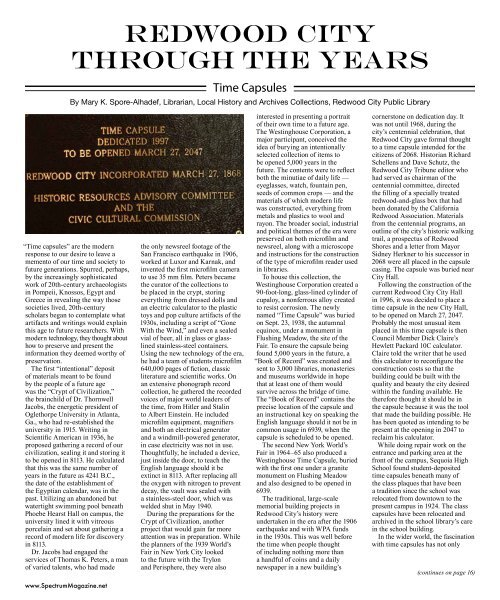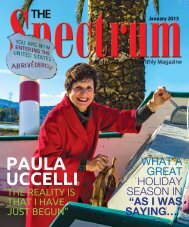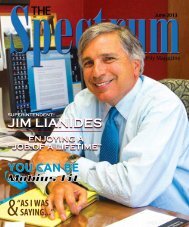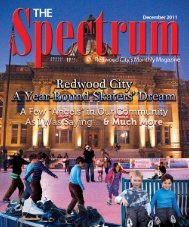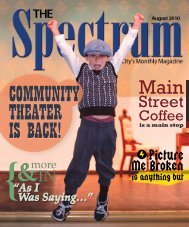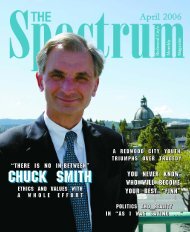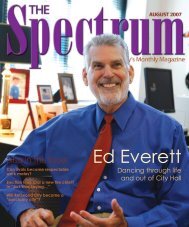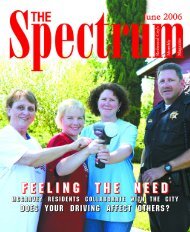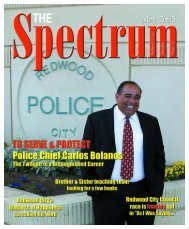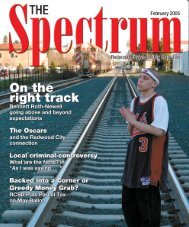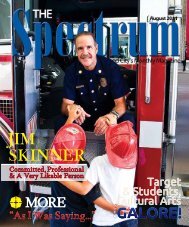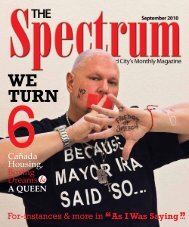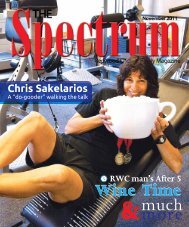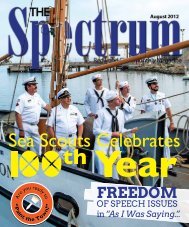John Bruno - The Spectrum Magazine - Redwood City's Monthly ...
John Bruno - The Spectrum Magazine - Redwood City's Monthly ...
John Bruno - The Spectrum Magazine - Redwood City's Monthly ...
You also want an ePaper? Increase the reach of your titles
YUMPU automatically turns print PDFs into web optimized ePapers that Google loves.
REDWOOD CITY<br />
THROUGH THE YEARS<br />
Time Capsules<br />
By Mary K. Spore-Alhadef, Librarian, Local History and Archives Collections, <strong>Redwood</strong> City Public Library<br />
“Time capsules” are the modern<br />
response to our desire to leave a<br />
memento of our time and society to<br />
future generations. Spurred, perhaps,<br />
by the increasingly sophisticated<br />
work of 20th-century archaeologists<br />
in Pompeii, Knossos, Egypt and<br />
Greece in revealing the way those<br />
societies lived, 20th-century<br />
scholars began to contemplate what<br />
artifacts and writings would explain<br />
this age to future researchers. With<br />
modern technology, they thought about<br />
how to preserve and present the<br />
information they deemed worthy of<br />
preservation.<br />
<strong>The</strong> first “intentional” deposit<br />
of materials meant to be found<br />
by the people of a future age<br />
was the “Crypt of Civilization,”<br />
the brainchild of Dr. Thornwell<br />
Jacobs, the energetic president of<br />
Oglethorpe University in Atlanta,<br />
Ga., who had re-established the<br />
university in 1915. Writing in<br />
Scientific American in 1936, he<br />
proposed gathering a record of our<br />
civilization, sealing it and storing it<br />
to be opened in 8113. He calculated<br />
that this was the same number of<br />
years in the future as 4241 B.C.,<br />
the date of the establishment of<br />
the Egyptian calendar, was in the<br />
past. Utilizing an abandoned but<br />
watertight swimming pool beneath<br />
Phoebe Hearst Hall on campus, the<br />
university lined it with vitreous<br />
porcelain and set about gathering a<br />
record of modern life for discovery<br />
in 8113.<br />
Dr. Jacobs had engaged the<br />
services of Thomas K. Peters, a man<br />
of varied talents, who had made<br />
the only newsreel footage of the<br />
San Francisco earthquake in 1906,<br />
worked at Luxor and Karnak, and<br />
invented the first microfilm camera<br />
to use 35 mm film. Peters became<br />
the curator of the collections to<br />
be placed in the crypt, storing<br />
everything from dressed dolls and<br />
an electric calculator to the plastic<br />
toys and pop culture artifacts of the<br />
1930s, including a script of “Gone<br />
With the Wind,” and even a sealed<br />
vial of beer, all in glass or glasslined<br />
stainless-steel containers.<br />
Using the new technology of the era,<br />
he had a team of students microfilm<br />
640,000 pages of fiction, classic<br />
literature and scientific works. On<br />
an extensive phonograph record<br />
collection, he gathered the recorded<br />
voices of major world leaders of<br />
the time, from Hitler and Stalin<br />
to Albert Einstein. He included<br />
microfilm equipment, magnifiers<br />
and both an electrical generator<br />
and a windmill-powered generator,<br />
in case electricity was not in use.<br />
Thoughtfully, he included a device,<br />
just inside the door, to teach the<br />
English language should it be<br />
extinct in 8113. After replacing all<br />
the oxygen with nitrogen to prevent<br />
decay, the vault was sealed with<br />
a stainless-steel door, which was<br />
welded shut in May 1940.<br />
During the preparations for the<br />
Crypt of Civilization, another<br />
project that would gain far more<br />
attention was in preparation. While<br />
the planners of the 1939 World’s<br />
Fair in New York City looked<br />
to the future with the Trylon<br />
and Perisphere, they were also<br />
interested in presenting a portrait<br />
of their own time to a future age.<br />
<strong>The</strong> Westinghouse Corporation, a<br />
major participant, conceived the<br />
idea of burying an intentionally<br />
selected collection of items to<br />
be opened 5,000 years in the<br />
future. <strong>The</strong> contents were to reflect<br />
both the minutiae of daily life —<br />
eyeglasses, watch, fountain pen,<br />
seeds of common crops — and the<br />
materials of which modern life<br />
was constructed, everything from<br />
metals and plastics to wool and<br />
rayon. <strong>The</strong> broader social, industrial<br />
and political themes of the era were<br />
preserved on both microfilm and<br />
newsreel, along with a microscope<br />
and instructions for the construction<br />
of the type of microfilm reader used<br />
in libraries.<br />
To house this collection, the<br />
Westinghouse Corporation created a<br />
90-foot-long, glass-lined cylinder of<br />
cupaloy, a nonferrous alloy created<br />
to resist corrosion. <strong>The</strong> newly<br />
named “Time Capsule” was buried<br />
on Sept. 23, 1938, the autumnal<br />
equinox, under a monument in<br />
Flushing Meadow, the site of the<br />
Fair. To ensure the capsule being<br />
found 5,000 years in the future, a<br />
“Book of Record” was created and<br />
sent to 3,000 libraries, monasteries<br />
and museums worldwide in hope<br />
that at least one of them would<br />
survive across the bridge of time.<br />
<strong>The</strong> “Book of Record” contains the<br />
precise location of the capsule and<br />
an instructional key on speaking the<br />
English language should it not be in<br />
common usage in 6939, when the<br />
capsule is scheduled to be opened.<br />
<strong>The</strong> second New York World’s<br />
Fair in 1964–65 also produced a<br />
Westinghouse Time Capsule, buried<br />
with the first one under a granite<br />
monument on Flushing Meadow<br />
and also designed to be opened in<br />
6939.<br />
<strong>The</strong> traditional, large-scale<br />
memorial building projects in<br />
<strong>Redwood</strong> City’s history were<br />
undertaken in the era after the 1906<br />
earthquake and with WPA funds<br />
in the 1930s. This was well before<br />
the time when people thought<br />
of including nothing more than<br />
a handful of coins and a daily<br />
newspaper in a new building’s<br />
cornerstone on dedication day. It<br />
was not until 1968, during the<br />
city’s centennial celebration, that<br />
<strong>Redwood</strong> City gave formal thought<br />
to a time capsule intended for the<br />
citizens of 2068. Historian Richard<br />
Schellens and Dave Schutz, the<br />
<strong>Redwood</strong> City Tribune editor who<br />
had served as chairman of the<br />
centennial committee, directed<br />
the filling of a specially treated<br />
redwood-and-glass box that had<br />
been donated by the California<br />
<strong>Redwood</strong> Association. Materials<br />
from the centennial programs, an<br />
outline of the city’s historic walking<br />
trail, a prospectus of <strong>Redwood</strong><br />
Shores and a letter from Mayor<br />
Sidney Herkner to his successor in<br />
2068 were all placed in the capsule<br />
casing. <strong>The</strong> capsule was buried near<br />
City Hall.<br />
Following the construction of the<br />
current <strong>Redwood</strong> City City Hall<br />
in 1996, it was decided to place a<br />
time capsule in the new City Hall,<br />
to be opened on March 27, 2047.<br />
Probably the most unusual item<br />
placed in this time capsule is then<br />
Council Member Dick Claire’s<br />
Hewlett Packard 10C calculator.<br />
Claire told the writer that he used<br />
this calculator to reconfigure the<br />
construction costs so that the<br />
building could be built with the<br />
quality and beauty the city desired<br />
within the funding available. He<br />
therefore thought it should be in<br />
the capsule because it was the tool<br />
that made the building possible. He<br />
has been quoted as intending to be<br />
present at the opening in 2047 to<br />
reclaim his calculator.<br />
While doing repair work on the<br />
entrance and parking area at the<br />
front of the campus, Sequoia High<br />
School found student-deposited<br />
time capsules beneath many of<br />
the class plaques that have been<br />
a tradition since the school was<br />
relocated from downtown to the<br />
present campus in 1924. <strong>The</strong> class<br />
capsules have been relocated and<br />
archived in the school library’s care<br />
in the school building.<br />
In the wider world, the fascination<br />
with time capsules has not only<br />
(continues on page 16)<br />
www.<strong>Spectrum</strong><strong>Magazine</strong>.net


